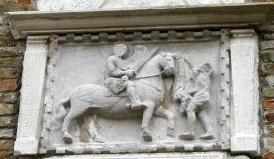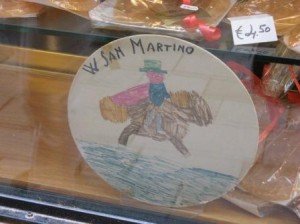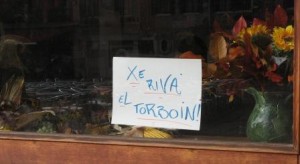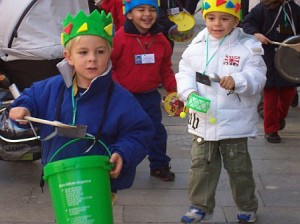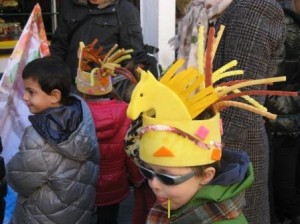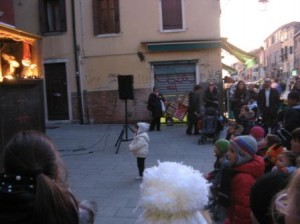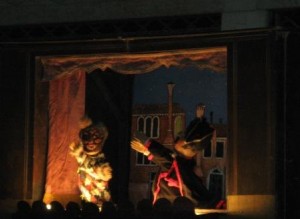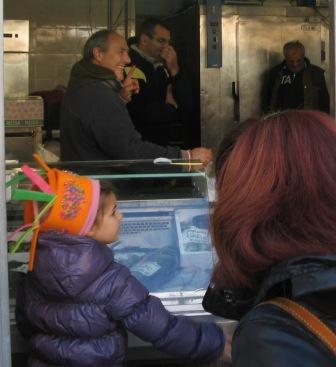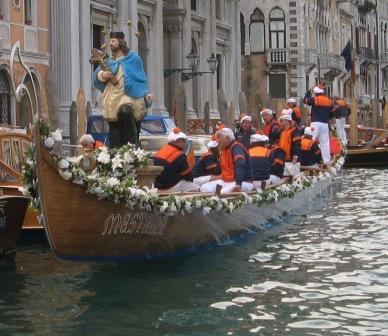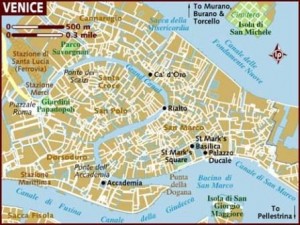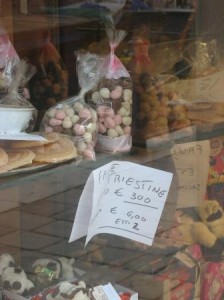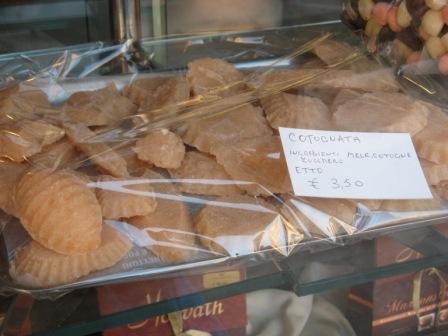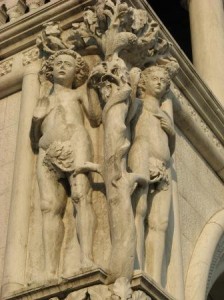
On Saturday a moderately publicized event was staged here which was billed as the “Funeral of Venice.” It was organized by a local group/social site called venessia.com. (This is the way Venezia is spelled in Venetian. Disclosure: I’m signed up but I hardly ever visit.) I didn’t attend but I was aware of the drumbeats leading up to it and cast my eye over the assorted coverage in its wake.
The event consisted of loading a fuchsia-tinted casket onto a six-oar balotina and carrying it, followed by a sort of funeral cortege of boats, down the Grand Canal from the train station to Ca’ Farsetti, or City Hall, by the Rialto Bridge. There was also an enormous floral wreath with the traditional ribbon from the bereaved donor: “Venetian Citizens,” it read.
The casket was carried into the atrium and a sort of funeral oration was declaimed. Then some people kicked the casket to pieces and a flag with the symbol of the phoenix (rebirth, hint hint) was taken out. At least they didn’t dig a grave somewhere out along the sidewalk and bury the thing. All this was moderately covered by the local press, it being Saturday and evidently a slow news day. But it was covered more extensively by the foreign press, perhaps being tired of covering the usual stories of death and dismemberment from around the world. So they came for a different story of death and dismemberment, the municipal variety.
The motivation for this moderately unusual gesture was to draw the world’s attention — or if not the world, the city government — to the fact that the population of the city had just dropped below 60,000. Of course the city government already knew that but didn’t interpret it in the same way as the protesters. I’m not sure the government interpreted it at all.
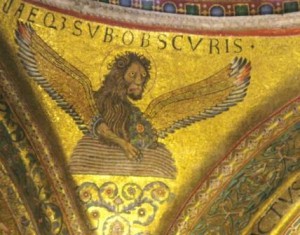
What’s so significant about 60,000? Because this is the number at which a settlement is defined as a “city.” Therefore, having fewer, Venice has now become a town. After which a village, I suppose, then a hamlet, then a hermit’s refuge.
“The city doesn’t want to resign itself to becoming a modern Pompei,” said actor Cesare Colonnese as part of his oration, to the assembled multitude of foreign reporters — according to the Gazzettino, there were four taxis full of journalists, and a barge with somebody playing the piano. “Danse Macabre” would have been a good choice. (Actually he was playing “Funeral March” by Chopin.) All in all, the account as given sounds more like something concocted for Carnival than anything else. Needless to say, no politicians showed up.
At a mere two days’ distance it’s hard to make a judgment on the impact this event might have had on public policy and the future of the city. If discernible, it too would be moderate, I’d guess. It mostly had the aroma of the sort of wailing and gnashing of teeth that goes on here for almost any reason you can come up with, said wailing and gnashing being totally justified and virtually always ineffective. And not really all that satisfying, I believe, because like anything else it can become a habit and therefore loses much of its pleasure.
In any case, the city government has never responded to wailing and gnashing. Where mere citizens (and not economic sectors) are concerned, it is wail- and gnash-proof.
Lino, who belongs to the class — Venetians born and bred — which some believe ought to be first on the barricades, was massively uninterested. Not that the fate of his city doesn’t interest him, but scenarios like the casket seem to come with futility and foolishness already installed, making them useless for any serious work that has to be done.
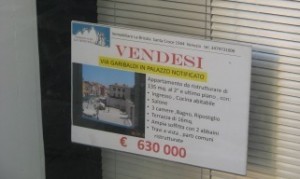
First of all, he noted that of the people who responded, a large contingent were foreigners. No disrespect intended, but when a call to arms, however well-meant, comes more from without than within, it’s a symptom that something is already out of kilter. If the city government doesn’t respond to its own citizens, who presumably have a long-term stake (fancy way of saying “pay taxes”), it’s unlikely that it will respond to those who mostly don’t.
But the story is simpler than all this. Lino ran me through it:
“A lot of the Venetians who moved to the mainland used to live in cellars,” he stated. Venice doesn’t have cellars, but it’s as close as I can come to the real word he used — magazzini — those humid, moldy street-level areas never intended as dwellings because of their propensity to flood, but which are universally useful as storage space for anything that isn’t bothered by humidity or mold. But people lived in them all the same because they didn’t have anywhere else — this large cohort not being nobility, obviously, or even the middle class, but what once was a large working class and whoever is below that.
Many Venetians of his era –say, from before World War II to something like ten to 15 years after it — remember how much miseria there was. “Miseria” is a very useful word because it not only connotes poverty, but everything physical and emotional that goes along with it, which could also be called “misery.” A friend of mine remembers the family that lived upstairs, who sometimes came down to their apartment to get warm. His mother would occasionally give them meat. He remembers houses that smelled of “cold ashes.”

“It was a dirty, provincial, poverty-stricken backwater,” Time magazine noted in a review of an exhibition in 1936. The unnamed reporter was referring to the city in the 18th century, but not so very much had changed by the 20th. In 1900 a cholera epidemic broke out; not difficult in a city surrounded by water, but a classic threat to those weakened by malnutrition and general crud. “Death in Venice” was written not long afterward(1911), and although the title reeks of romance, the death itself merely reeks. It was cholera, a disease which has no aesthetic component whatever even if the protagonist was staying in a fancy hotel on the Lido.
In reporting on the 1836 epidemic, a British medical journal said this: “The proportion of cholera patients in the poorest to those in the wealthiest parishes in Venice is 100 to 15,” it stated. People who were especially susceptible were “persons of irregular habits and diet… using bad food…affected with chronic complaints…poor…over-worked…dirty.”
Lino remembers children with lice, scabies, typhus. Not that the city was some huge slum, but it wasn’t exactly an autoclave, either.
“When people got the chance live in something better, of course they took it,” he went on.
It’s common knowledge now, as it has been for decades, that the cost of real estate in Venice is fabulously high and just keeps going higher. So if anybody had the slightest opportunity to trade up, they took it.
“For what they would pay for a small magazzino here, they could get a big apartment on the mainland, with a garage and garden and elevator and everything.” But they didn’t count on the emotional element, and he says that many of these transfers had the chance to come back, they’d do it in a flash.
So why don’t they?

“The plain fact behind all this is that the cost of real estate has now reached a level which is unattainable for most people,” he said. “And don’t forget” — here it comes — “it’s also Venetians who are the cause. If someone has an apartment to sell, he’s obviously going to put the highest possible price on it. A price which only a foreigner could pay, even if they only come here a few days or weeks of the year. Just walk around — there are so many houses that are shut up.”
This is true; it’s not uncommon for people to ask me what’s up with all the closed shutters.
Venetians, knowing all this, are at a loss to find a handhold on the situation. But this Saturday-morning ceremony was a worthy attempt and it did make for a moderately dramatic interlude at City Hall. The city intermittently devises some new plan to address this situation, but as they say here, “The law is made, the loophole is found.” A number of those new apartments on the Giudecca a few years ago that were supposed to be reserved for Venetians? Certain conditions weren’t imposed on the terms of sale, so Venetians were buying them — and then reselling them at inflated prices.
The Councilor for Housing, Mara Rumiz, had the grace to hold a press conference at which she discussed some initiatives to confront the housing situation. I feel that ought to be acknowledged.
Cesare Colonnese, an actor who gave the discourse, had this to say on his website (in Italian and at the end in Venetian): “…I don’t want to get into discussing politics and I don’t know if talking about responsibility is always correct. I think in this case the responsibility should also be on the part of all of us. It’s also up to us to do something for Venice, it’s also up to us to set a good example…. We Venetians shouldn’t always present ourselves as complainers and never content. Each one of us, from the artisan to the glass-maker, from the baker to the pizza-maker, has a craft in his hands and the potential to show themselves and others that Venice is a strong city that’s capable of being reborn. Venice doesn’t have to lose its characteristics and traditions. We have to raise our children teaching them to love these customs and traditions because they will be the future of this city [Note to Cesare: Are you going to stem the mania for celebrating Halloween here, which nobody has any idea what it is except some new fad the kids insist on pursuing? I’d vote for starting here with the old defend-our-traditions project]. It’s useless to leave with our tails between our legs, because by leaving we lose contact with this reality as well as, in my opinion, the right to complain. Who says that Venice is dead? It’s time to quit this talk while just sitting around. So get up! Get up! You too, go and do something!” Like what? SOMETHING. I’ll get right on it!
The Gazzettino reported a smattering of comments across the spectrum of onlookers. One 70-year-old Venetian man said, “Nobody has worked right down to the bottom on the issue of residentiality for Venetians,” he said. “We need to bring Venetians back to the city and this should be the work of a good administration.” Affordable housing, in two words.
“I think it’s silly,” remarked a young Venetian woman who moved to Mestre. “I’d never move back to Venice. I come here to work, but it’s better to stay away from the city, which at this point has more disadvantages than luxuries.” Points for candor.
“I’d never have thought we could reach this point,” commented a retired grocer — “a demonstration about being able to live in Venice. I’d like to put the politicians in the casket.”
A jeweler who lives on the mainland thought it was a joke. “The destiny of Venice is the same as all the ‘art cities,'” he said. “It’s a world in evolution.” And in fact I have heard this from others — that many of Venice’s problems are also problems in Florence, and elsewhere. The residents are under siege wherever tourism has unhinged the economic equilibrium.
Well, at least this time the story about Venice sinking isn’t about water or tourists. What would it be sinking beneath? Just about everything except gluttony, although when the ceremony was over there were refreshments. As everyone is fond of observing, “All the psalms finish with the Gloria.” The happy ones, the tragic ones — whatever is going on, make sure you’ve got snacks. Oh, and drinks. They had Prosecco, naturally. No point in suffering needlessly.

